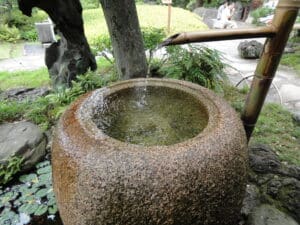A JAPANESE GARDEN HANDBOOK
by Andrew R. DeanePart Three: Ancillary Elements
Discussing additional elements that make a garden peculiarly Japanese: Paths, bridges, lanterns, water basins, and stone towers; architecture, gates, walls, fences and borrowed scenery.
Chapter 29: Getting about: Paths
In this Chapter… A Stroll through the Garden Dressing Up Stepping Out Cutting a Swath Stopping Short A Stroll through the Garden Paths (yūhodō 遊歩道; komichi 小径;...
Chapter 30: Crossing over: Bridges
In this Chapter… Metaphor and Reality Across the Years Stone Spans Wooden Arches A monk challenged Zhaozhou, “I’ve been hearing about Zhaozhou’s stone bridge...
Chapter 31: Lighting the Way: Lanterns
In this Chapter… Dispelling Darkness A Little Illumination Seven Bits and Pieces Four Classifications Eighteen Styles Takatōrōhiru-wa mono ukihashira kana...
Chapter 32: Washing away the World: Basins
In this Chapter… Origins and Ablutions Stone Basin Crouching Down Basin Styles Wells and Water Devices koke nagarahana ni naraburuchōzubachi Lined up with the...
Chapter 33: Detailing the Garden: Towers and Ornaments
In this Chapter… Pagodas Stone Towers Stone Ornaments Re-use, Re-cycle Pagodas Pagodas are adaptations of Indian burial stupas, and derive their religious symbolism...
Chapter 34: Placing Man: The Architectural Interface
In this Chapter… Essential Principles Raising the Roof Walls, Windows and Screens Guest Rooms On the Mat Transitional Zones Draining the Rain Garden Delights Domestic Bliss Four Architectural Styles Domestic Bliss Mad about Town Castle Complex Imperial Concerns...
Chapter 35: Defining the Garden: Boundaries and Gates
In this Chapter… Fencing Practice Bamboo Tying the Knot Board Brushwood and Bark Living Fences Mud, Stone and Tile Their Entrances and Their Exits Stoned at the Gate [wa_restricted roles="Not:Public" login_label="Log in" message="Log on to view restricted...
Chapter 36: Looking Beyond: Borrowed Scenery
In this Chapter… Borrowing a Backdrop Incredible Shrinking Scenery Let Us Now Praise Famous Places Jetavana’s Bells Gardens of Repute Mythic Mountains Rising from the Ashes [wa_restricted roles="Not:Public" login_label="Log in" message="Log on to view restricted...
Table of Contents
Chapter 29: Getting about: Paths
A Stroll through the Garden; Dressing Up; Stepping Out; Cutting a Swath; Stopping Short
Chapter 30: Crossing over: Bridges
Metaphor and Reality; Across the Years; Stone Spans; Wooden Arches
Chapter 31: Lighting the Way: Lanterns
Dispelling Darkness; A Little Illumination; Seven Bits and Pieces; Four Classifications; Eighteen Styles
Chapter 32: Washing away the World: Basins
Origins and Ablutions; Stone Basin; Crouching Down; Basin Styles; Wells and Water Devices
Chapter 33: Detailing the Garden: Towers and Ornaments
Pagodas; Stone Towers; Stone Ornaments; Re-use, Re-cycle
Chapter 34: Placing Man: The Architectural Interface
Essential Principles; Raising the Roof; Walls, Windows and Screens; Guest Rooms; On the Mat; Transitional Zones; Draining the Rain; Garden Delights; Domestic Bliss; Four Architectural Styles; Domestic Bliss; Mad about Town; Castle Complex; Imperial Concerns; Retirement – Imperial Style
Chapter 35: Defining the Garden: Boundaries and Gates
Fencing Practice; Bamboo; Tying the Knot; Board; Brushwood and Bark; Living Fences; Mud, Stone and Tile; Their Entrances and Their Exits; Stoned at the Gate
Chapter 36: Looking beyond: Borrowed Scenery
Borrowing a Backdrop; Incredible Shrinking Scenery; Let Us Now Praise Famous Places; Jetavana’s Bells; Gardens of Repute; Mythic Mountains; Rising from the Ashes








